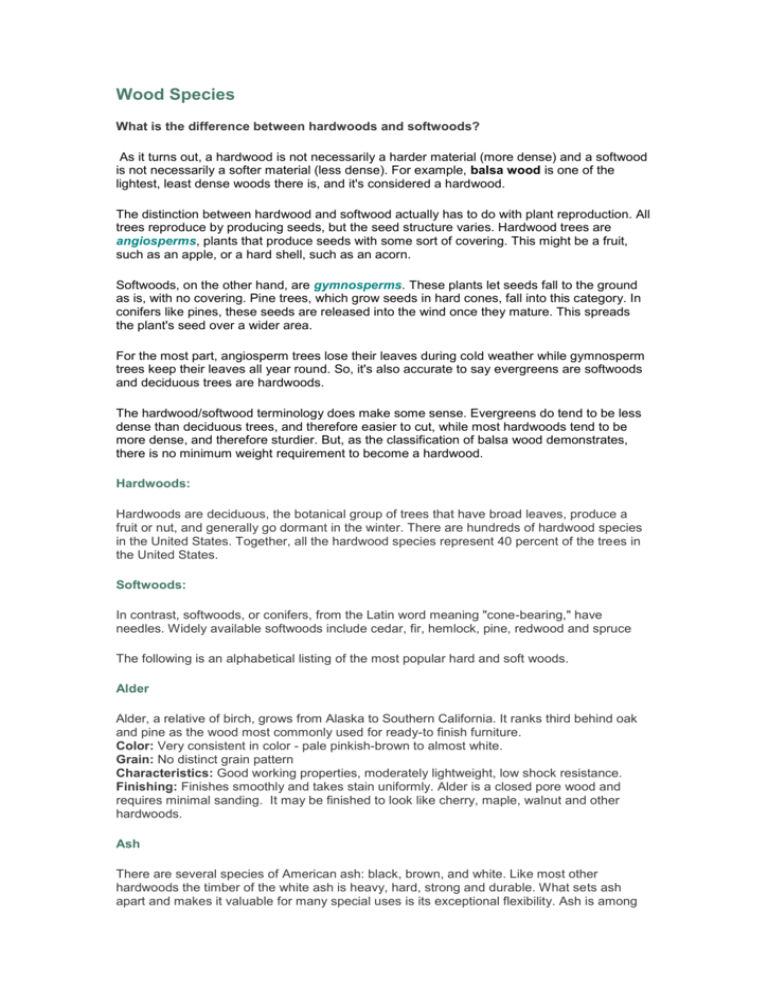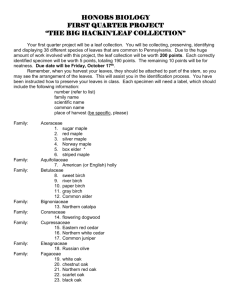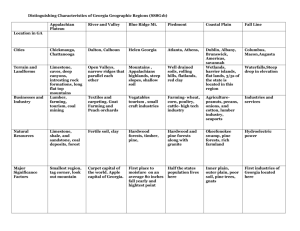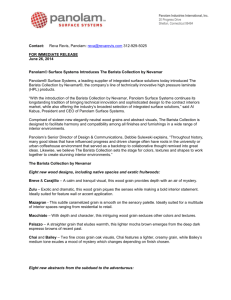Difference between hard-soft woods
advertisement

Wood Species What is the difference between hardwoods and softwoods? As it turns out, a hardwood is not necessarily a harder material (more dense) and a softwood is not necessarily a softer material (less dense). For example, balsa wood is one of the lightest, least dense woods there is, and it's considered a hardwood. The distinction between hardwood and softwood actually has to do with plant reproduction. All trees reproduce by producing seeds, but the seed structure varies. Hardwood trees are angiosperms, plants that produce seeds with some sort of covering. This might be a fruit, such as an apple, or a hard shell, such as an acorn. Softwoods, on the other hand, are gymnosperms. These plants let seeds fall to the ground as is, with no covering. Pine trees, which grow seeds in hard cones, fall into this category. In conifers like pines, these seeds are released into the wind once they mature. This spreads the plant's seed over a wider area. For the most part, angiosperm trees lose their leaves during cold weather while gymnosperm trees keep their leaves all year round. So, it's also accurate to say evergreens are softwoods and deciduous trees are hardwoods. The hardwood/softwood terminology does make some sense. Evergreens do tend to be less dense than deciduous trees, and therefore easier to cut, while most hardwoods tend to be more dense, and therefore sturdier. But, as the classification of balsa wood demonstrates, there is no minimum weight requirement to become a hardwood. Hardwoods: Hardwoods are deciduous, the botanical group of trees that have broad leaves, produce a fruit or nut, and generally go dormant in the winter. There are hundreds of hardwood species in the United States. Together, all the hardwood species represent 40 percent of the trees in the United States. Softwoods: In contrast, softwoods, or conifers, from the Latin word meaning "cone-bearing," have needles. Widely available softwoods include cedar, fir, hemlock, pine, redwood and spruce The following is an alphabetical listing of the most popular hard and soft woods. Alder Alder, a relative of birch, grows from Alaska to Southern California. It ranks third behind oak and pine as the wood most commonly used for ready-to finish furniture. Color: Very consistent in color - pale pinkish-brown to almost white. Grain: No distinct grain pattern Characteristics: Good working properties, moderately lightweight, low shock resistance. Finishing: Finishes smoothly and takes stain uniformly. Alder is a closed pore wood and requires minimal sanding. It may be finished to look like cherry, maple, walnut and other hardwoods. Ash There are several species of American ash: black, brown, and white. Like most other hardwoods the timber of the white ash is heavy, hard, strong and durable. What sets ash apart and makes it valuable for many special uses is its exceptional flexibility. Ash is among the most easily steam-bent hardwood species. Early windmills were made form Ash. Ash is also used extensively in the manufacture of sporting goods. We all know that baseball bats are made from white ash. Ash is a popular species for food containers because the wood has no taste. Color: Nearly pure lustrous white, ranging through cream to very light brown. Grain: It has an attractive, straight, moderately open, pronounced grain. Characteristics: Heavy, hard, strong and stiff excellent bending qualities. Finishing: Because of its large pores it is seldom painted but takes all other finishes very well. Aspen Both quaking and big tooth aspen are readily available as lumber in the western U.S. Because of it's neutral odor and taste, it is used for food containers and other food industry needs. In recent years it has become increasingly important in the manufacture of wood furniture. Color: Very light and white in appearance. Grain: Very even grained. Finishing: Ideal for non-penetrating finishes such as water based stains and paints. Beech Related to the oak and chestnut, beech is most common in the higher altitudes of the Appalachian Mountain chain. Elegant and attractive, the American beech is a medium tall tree with the smoothest of all bark. It grows, naturally, along mountain slopes and rich uplands in nearly pure stands. It tolerates shade well making it one of the forest trees that can thrive beneath the canopy of taller species. American beech is an important timber species. It is highly adaptable to steam bending while retaining its strength. It is excellent for woodturning, wears well and takes preservatives well. Because beechwood becomes slick with wear, it is perfect for drawer sides and runners. Because it bends well, it is used in bent wood chairs and other bent wood furniture. It does not impart flavor, odor or color to food so it is good for food utensils and containers. Color: Wood ranges from nearly white to deep red brown. Grain: Close and straight grained, with little figure and a uniform texture, identified by its dark pores in conspicuous rays. Characteristics: Hard and strong. Good resistance to abrasive wear. Finishing: Easy to paint, stain or bleach. Birch Yellow birch is a deciduous hardwood which grows principally in the upland, hilly terrain of the Northeastern and Lake States forests: There are nine species of birch native to North America, including the very distinctive and familiar white trunked paper birch. But the species named yellow birch is the most common and important commercial lumber birch. It is identified by its bright, yellowish bronze colored bark that peels in long, thin horizontal strips. Color: Cream or lightly tinged with red. Grain: Fine grained (often curly or wavy). Characteristics: Heavy, strong, hard, and even-textured. Finishing: Birch takes paints and stains well. Cherry Like all fruit trees, cherry belongs to the rose family and was used as early as 400 B.C. by the Greeks and Romans for furniture making. Cherry helped define American traditional design because Colonial cabinetmakers recognized its superior woodworking qualities. Today, cherry helps define Shaker, Mission and country styling. The wood from the cherry tree can be described in a single word: beautiful. Its rich red-brown color deepens with age. Small dark gum flecks add to its interest. Distinctive, unique figures and grains are brought out through quarter sawing. It has an exceptionally lustrous appearance that glows. The finish is satiny to the touch Color: Rich, reddish-brown. Cherry darkens considerably with age and exposure to sunlight. Grain: Straight-grained and satiny. Small gum pockets produce distinctive markings. Characteristics: Light, strong, stiff and rather hard. Cherry's grain is more subdued than some other hardwood species, with very interesting character. Finishing: Cherry is unsurpassed in its finishing qualities-its uniform texture takes a finish very well. Eucalyptus Eucalyptus is a hard wood that earns high marks for strength, durability and offers excellent weathering characteristics. The eucalyptus genus represents more than 300 species. They have been successfully planted in South America, South Africa, Europe and the United States. Color:It is pinkish-brown in color and turns to a reddish-brown with age and exposure to light. Characteristics: Its' resistance to decay is relative to teak. Eucalyptus is a heavy hardwood that earns high marks for strength. Eucalyptus is a renewable resource with high productivity in relatively short harvest rotations. The wood in these products comes from well managed forests, independently certified in accordance with the rules of the Forest Stewardship Council (FSC). Finishing: When finished with a high quality penetrating oil, mixed with the stain of your choice, Eucalyptus takes on a teak-like appearance. We recommend that you use one of the commercially available deck oils. To maintain a new look, occasionally clean and reseal the furniture. This furniture can be painted as well. Hickory A Native American tree, hickories are members of the walnut family. Hickory is the hardest, heaviest and strongest American wood in common use. Westward trekking pioneers allegedly made hickory a prerequisite for their wagon wheels. Color: White to tan to reddish-brown with inconspicuous fine brown lines. Grain: Fine grain. Characteristics: Extremely tough and resilient, even texture, quite hard and only moderately heavy. Finishing: The grain pattern welcomes a full range of medium-to-dark finishes and bleaching treatments. Mahogany The heavyweight of all woods, mahogany is one of the most valuable timber trees. Popular in the '50's, mahogany is making a comeback due to the new attraction to the "red" woods. On an interesting note, new model automobiles were originally carved, full sized, entirely out of mahogany! Each piece, no matter how big or small, from the front bumper, to the engine, the dashboard, the drive shaft, back to the lock on the trunk is first fashioned from this very stable hard wood. Color: Varies from light red or pale tan to a rich dark deep red or deep golden brown, depending on country of origin. Grain: It is generally straight grained but is prized for its figures which include stripe, roe, curly, blister, fiddleback, and mottle. Characteristics: Extremely strong, hard, stable and decay resistant Finishing: Finishes and stains to a beautiful natural luster. Maple The American species of maple are divided into two groups: Hard maple, which includes sugar and black maple; and soft maple, which includes red and silver maple. Until the turn of the century, the heels of women's shoes were made from maple, as were airplane propellers in the 1920s. Maple has been a favorite of American furniture makers since early Colonial days. Hard maple is the standard wood for cutting boards because it imparts no taste to food and holds up well. Color: Cream to light reddish-brown. Grain: Usually straight-grained and sometimes found with highly figured bird's-eye or burl grain. Bird's-eye resembles small circular or elliptical figures. Clusters of round curls are known as burl. Characteristics: Heavy, hard, strong, tough, stiff, close-grained and possesses a uniform texture. Maple has excellent resistance to abrasion and indentation, making it ideal flooring as well as cutting boards and countertops. Finishing: Takes stain satisfactorily and polishes well. Oak The oaks-red and white-are the most abundant U.S. hardwood species. It would be difficult to name a wood with a longer and more illustrious history in furnishings and interior design. Oak was a favorite of early English craftsmen and a prized material for American Colonists. White oak is just one of 86 oak species native to this country, but it is the classic oak of America. Although prevalent throughout the eastern half of the United States, from Maine to Texas, white oak lumber comes chiefly from the South, South Atlantic and Central States, including the southern Appalachians. Red oak grows only in North America and is found further north than any other oak species. A big, slow growing tree, red oak takes 20 years to mature and lives an average of 300 years. Color: White Oak- ranges from nearly white sapwood to a darker gray brown heartwood, Red Oak-ranges from nearly white cream color to a beautiful warm, pale brown heartwood, tinted with red. Grain: The grain is distinguished by rays, which reflect light and add to its attractiveness. Depending on the way the logs are sawn into timber (rift-cut, flat sliced, flat sawn, rotary cut, quartered), many distinctive and sought after patterns emerge: flake figures, pin stripes, fine lines, leafy grains and watery figures. Characteristics: Heavy, very strong and very hard, stiff, durable under exposure, great wearresistance, holds nails and screws well. Uses: Flooring, furniture, cabinets, ships and decorative woodwork. Finishing: Oaks can be stained beautifully with a wide range of finish tones. Parawood Parawood is A Native tree of the Amazon Region of South America. Information about Parawood can be traced back to Christopher Columbus. It was during his second visit to South America, that he wondered at the heavy black ball the natives were using in games. This black ball was made from the vegetable gum of the Parawood tree. Later historians would also marvel at this substance, which bounced so much when thrown to the ground it appeared to be alive. In the 19th century an Englishman named Henry Wickham transported some seeds to England for germination. The seeds germinated and these small seedlings were then transported to the Malay Peninsula for planting; there to start the Great Rubber Plantations of Malaysia. After 25 to 30 years of latex production, tapped in the same manner syrup is tapped from the Maple trees, the tree ceases to produce sufficient quantities of latex. The tree is cut for processing in the manufacture of fine furniture and a new tree is planted in its place. Color: Pale yellow. Grain: Open grain similar to mahogany. Characteristics: A very hard wood. Finishing: Takes a very even stain. Pine (Radiata) Radiata Pine is a plantation-grown wood from South America and New Zealand that is harder than other pines and has fewer knots. Color: Pale cream color. Grain: Has a distinctive grain pattern. Finishing: Takes most finishes well. Pine (Southern Yellow) Southern Yellow Pine is actually a species group that is made up of primarily four trees: loblolly pine (Pinus taeda), long leaf pine (Pinus palustris), shortleaf pine (Pinus echinata) and slash pine (Pinus eliottii) Loblolly Pine is the most important and predominant of the four. It grows throughout the Atlantic Coastal Plain, often in commercial stands, from Maryland south through all the Carolinas and Georgia into Florida, and westward to East Texas. It is classified as a hard pine and is harder than white pine. Color: Warm pale yellow with brown knots. Grain: Distinctive light and dark grain pattern. Finishing: Pine takes most finishes well. End grain and spots that have been routed require extra sanding to prevent excessive penetration of stain. Knots in Pine furniture add color, interest and character; however they will “bleed” through washed or light finishes and they tend to darken with age. Always finish all surfaces including the bottom and inside with a clear coating of the finish coat. With some stains, a sealer helps prepare the wood to achieve a more even look.






